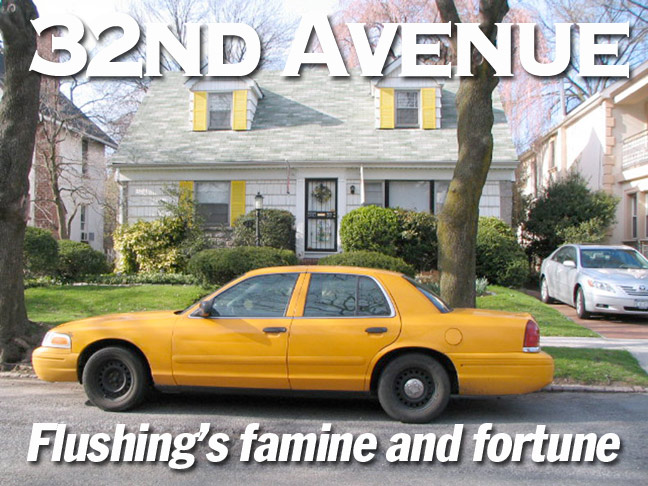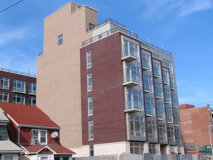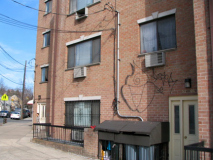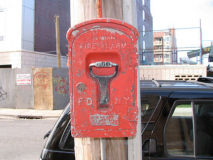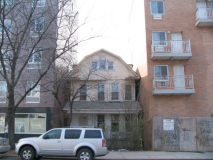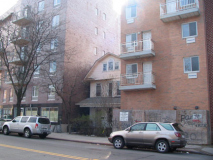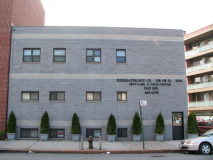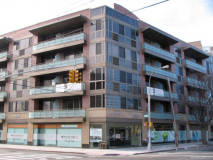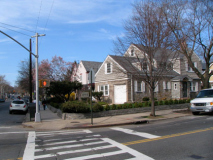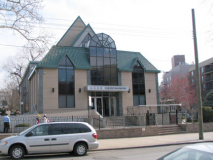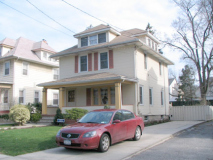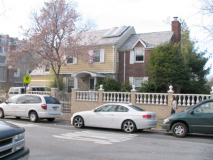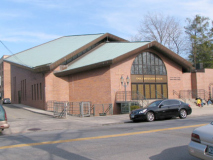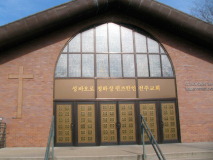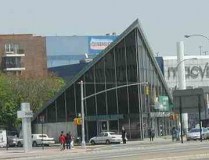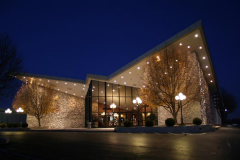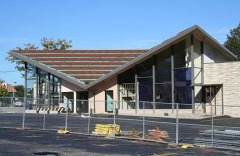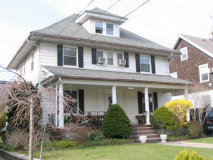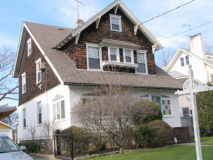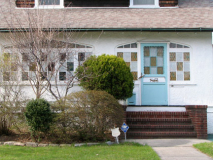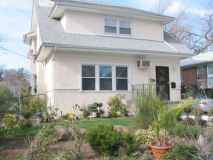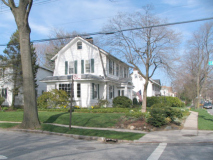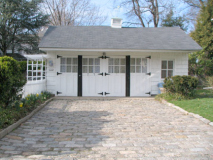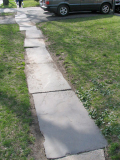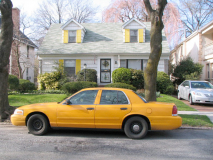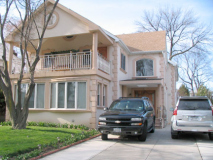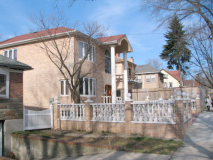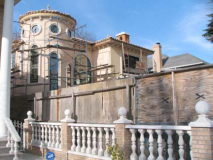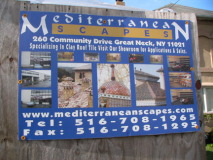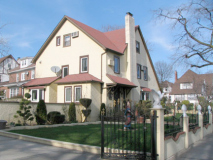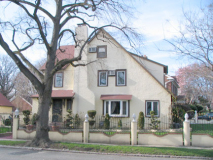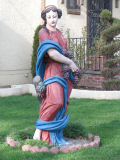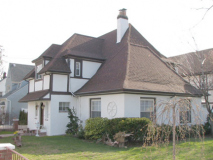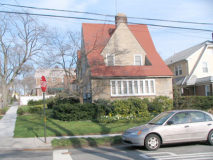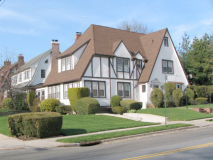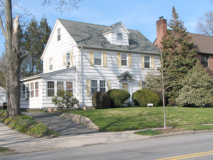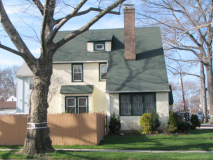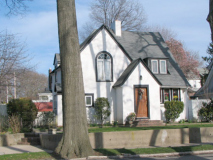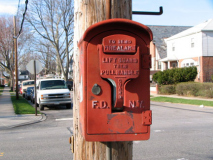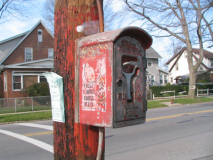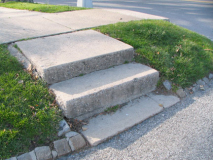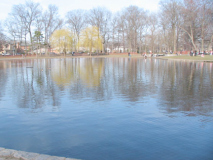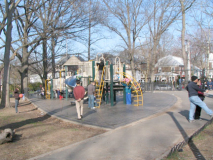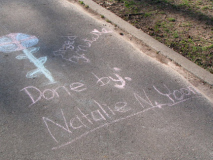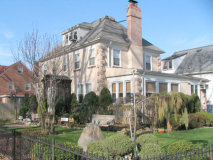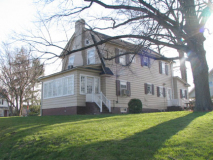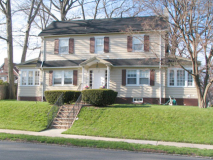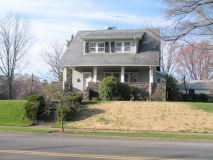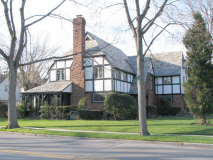It was a day as bright and crystal clear as April gets; I had returned home from taking a season ticket holders’ tour of the Mets’ brand-new Citifield. Getting back home around 2:30, it was still pretty early in the day so I went back on the Long Island Rail Road (which is only a block away from my house; I purposely bought an apartment situated close by) and got out at Flushing-Main Street, and got enough pictures for a couple of ForgottenPages before dusk set in, which it still does fairly early, in April.
Lately I have been contemplating my own tenaciousness. I am not attempting to backslap or self-compliment, and some may in fact attribute this trait to a lack of imagination or ambition. I have been with my present full-time job with a direct marketer for ten years in two separate stints, and have been associated with the place for 17 years (in 2009). I have had a part-time job with a local chain of newspapers for 13 years. I have written Forgotten NY for 10 years.
I have been thinking about these things for a variety of reasons. A couple of recent developments have put both my jobs in jeopardy and I may have to leave both of them soon. I have also been told I may need heart surgery to fix a valve. It will be a common procedure that is successful for most patients, but it is still surgery and I may be knocked out of action for awhile. I hope to be able to continue with Forgotten NY as early as possible during my recovery. But 2009 may be a year of transition in more than one way.
[Note: I indeed left both jobs and had the surgery]
Walking down Flushing’s 32nd Avenue, I thought about how most of it is hanging tough against forces that are destroying the rest of Queens. An apple has been shoved in Queens’ mouth as it is served on a platter to overdevelopers who have the full support, overt or covert, of most of the borough’s elected officials. We see the trend at 32nd Avenue’s western end, where elements of one of NYC’s ugliest neighborhoods are being allowed to gradually seep in, and we see what we will lose if the overdevelopers are allowed to carve up the neighborhoods through which 32nd Avenue runs on its eastern end…
32nd Avenue at Leavitt Street: I actually don’t much mind the stepped balconies, built to take advantage of morning sun, and large glass windows on the new building. There are no visible meters, Fedders air conditioners, or rusty balconies. Big windows are fine — just keep your shorts on. However, the new building is out of context with the cottage-like houses that seem to huddle together against the big bad onslaught. Across the street we have a more traditionally awful building, 1970s-vintage most likely, with the usual utilities on the exterior and de rigueur graffiti.
Scattered along 32nd Avenue are fire alarms of varying ages. This simple pull handle is one of the oldest of its type. I have actually glommed onto some line drawings of NYC’s fire alarm history from the 1910s to present, and if I can pull everything together it’d make a nice FNY piece.
Union Crap, sans Gary Puckett. When 32nd Avenue reaches Union Street, three of the four corners represent New Flushing, with one holding firm steadfastly in the early 20th Century from which it sprung. An incredibly odd and revolting tableau can be seen on the west side of Union, where one of its cottages from, let’s say 1910 or 1920, has been completely hemmed in by encroaching monsters. Would you buy this house now? It was once undoubtedly surrounded by houses that resembled it, with lush lawns, perhaps a model T in the garage or driveway. Was that so bad, really?
The SW and NW corners of Union and 32nd show us the new face of Flushing that the overdevelopers are saddling us with; cinderblocks and dull, faceless and unknowable construction. The NE corner has remained the same, more or less, for decades and is the face of Old Flushing. The newish Pure Presbyterian Church holds down the SE corner.
Since moving to Little Neck, I have spent little time immersed in the cesspool that downtown Flushing has become. It is finally living up to its name (a British corruption of the Dutch Vlissingen) after decades of sleepiness and peace. It is crowded, odiferous, and vile, and whatever architecture it once had is being wiped clean by overdevelopers who will not tolerate a patch of unoccupied space. It was a happy day July 1, 2007, my moving day to Little Neck. Ah, but how long will my victory last, until the forces that ruined Flushing press east?
2nd Avenue begins a transformation as you pass Union Street and walk east; it becomes more residential as you enter the community of Murray Hill. In many cases the streets and homes look exactly the same as they did when they were built near the beginning of the 20th Century. But many homeowners have had the imp of the perverse whispering in their ears. They don’t think it’s enough; cheezy Mediterranean balustrade fences topped with concrete globes are brought in, as well as the chrome fences that have become almost a required addition for newer houses in Queens. What was simple and elegant becomes 21st Century idiocy.
Give Me Wings
St. Paul Chong Ha-Sang Roman Catholic Church was constructed on Parsons Boulevard just south of 32nd Avenue in 1989; but its rhomboid roofs and building angles remind me of a style that briefly took hold in the middle of the Swingin’ Sixties, and then vanished, never to return. I don’t know the name of the style but I have an odd attraction to it.
I have always loved this building though many of other architecture aficionados make fun of it. It was designed by St. Louis architect William Cann in 1968 as a bank branch of the Jamaica Savings Bank and looks like a stingray, or a Stealth bomber. I don’t believe it has been landmarked, so it’s in danger of being torn down and replaced with something much blander, appropriate for a more timid age. See it while you can on Queens Boulevard and 55th Avenue.
The trend came to flower in other cities as well. The building at left was (I believe it may have been torn down) in a Milwaukee shopping center. At right is the Mark Twain Cinema in St. Louis, which has been reinvigorated after a few years of neglect as the Two Hearts Banquet Center. It was constructed in 1968, a time when sharp angles were popular.
ForgottenFan Richard Solensky: …”with regards to those buildings with “wings” and big plate glass windows, I believe they would be examples of “Googie”. While it started out as an architectural style in the 1950s, it soon became more of a design aesthetic, influencing things from the Lava Lamp to the famous “Welcome to Las Vegas” sign. The best place to see Googie is the TV show The Jetsons – *everything* there is Googie.
In New York, “Googie” was the basic design theme behind the 1964 World’s Fair – the Unisphere and the New York Pavilion are held as primary examples of the style. The old TWA Terminal at JFK (last seen in “Men in Black”) is another local example. The style is not entirely dead; I can claim that the new Greenburgh (NY) Town Library, with its upswept roof and lots of plate glass, is done in Googie.
Googie reflected the sense of optimism about the future in the late 50s and early 60s. All those big curves, fun colors, and brightness! Then society went to heck, and the future didn’t seem like such a nice place anymore. And since it was used primarily in small commercial buildings, like diners and bowling alleys, serious architects never considered it worthwhile or worth preserving. So many of the best examples are being allowed to fall in to ruin, or get bulldozed for something uglier, or even worse – blander.
Murray Hill
Murray Hill has never been a small town on its own, as so many Queens neighborhoods like Long Island City, Jamaica, Flushing or Newtown (today’s Elmhurst) had been. It’s always been considered to be the eastern end of Flushing, and been a planned development carved out of Flushing’s vast acreage of plant nurseries in the late 1800s. In 1889 developer Frederick Dunton, a shareholder in the Long Island Rail Road, purchased large parts of the Robert Bowne Parsons estate, divided it into lots that quickly were snapped up. A railroad stop, school and firehouse were built (their descendants remain in place today, though the original school is now a modern structure (PS 22, the Thomas Jefferson School, on Sanford Avenue east of Murray Street). Murray Hill did develop a separate suburban identity from Flushing that it retains today; though multistory apartment builings were constructed near the Murray Hill RR station, they had a panache that today’s quickly proliferating multifamily buildings lack.
Some of its more interesting and pleasant houses can be found here along 32nd Avenue between Union Street and Bowne Park. The one shown bottom left and right has some unusual colored glass on its front windows.
Some more of Murray Hill homes in the vicinity of 146th Street on 32nd Avenue. The stuccoed home is owned by avid gardeners. The house on the corner has a huge lawn and a carriage house next door that has a separate address and a Belgian-blocked driveway. Nearby is a bluestone sidewalk, perhaps an original.
When I passed this place I thought I had the perfect photo op. I like yellow trim on buildings in the first place, and then I saw this former cab parked outside. I rushed across the street and secured the shot. When I looked at it again, though, I realized its imperfections; NYC yellow cabs aren’t quite yellow, but yellow tending toward orange; there’s a bit of red mixed in. So, the windows and the cab aren’t the same color. I like the picture anyway.
It’s unfortunate what is happening to some parts of 32nd Avenue. The balustrade fence and globes are back (check the photo above, it’s exactly the same), and here’s some grandiose, faux Mediterranean. Here’s the phone number of the Rhodes scholars who perpetuate this sort of dreck. An effective argument for landmarking. One of the buildings actually has a lawn, but two big gas-guzzlers are parked in the driveway.
I firmly believe that regulation is in order. Homeowners have to occasionally be saved from themselves.
The building on the NW corner of 32nd Avenue and 148th Street contains detail that sets it apart. The driveway features a pair of charming lanterns, and on the lawn is a statue of what is likely the Greek goddess of agriculture and fertility, Demeter. From her Roman counterpart Ceres we derive the word cereal. In her earliest iterations, she was part horse, with serpents for hair. Fortunately, these idiosyncrasies were ironed out in later accounts.
All four corners of 32nd Avenue and 148th Street, actually, can claim fine architecture, at the SW corner a “country Tudor” (above left), a cottage with two A frames at the SE corner (above right) and the big Tudor with a large lawn and tasteful topiary (left).
At 149th, a brick mansion with casement windows, and another white gem with yellow trim.
Who doesn’t appreciate a neighborhood with homes that look like this on 32nd Avenue and 150th Street? Who would not want to see it protected? Overdevelopers and many of Queens’ elected officials.
A pair of 32nd Avenue fire alarms. The older ones have a simple pull handle, while the more recent ones have a guard. The newest ones have red and blue buttons where the caller has a choice to contact FDNY or NYPD. Note the old public service ad. How old? Well, it’s signed Edward Thompson, Fire Commissioner (invisible on this scan.) Thompson was in office between 1962 and 1965.
32nd Avenue intersects Murray Street at a slight elevation and the sidewalks require a couple of steps to reach the street on either side.
Though this house at 32nd Avenue and 155th has been resided fairly recently, it still has its old stone-pillared porch. What’s that green expanse in the background?
Bowne Park
Bowne Park, between 29th and 32nd Avenues and 155th and 159th Streets, is one of Murray Hill’s two major parks (along with the Memorial Field of Flushing, along 149th between Bayside Avenue and 25th Avenue).
It is named in honor of Walter Bowne (1770-1846), who served as a State Senator and as New York City Mayor. Bowne’s summer residence stood on this property until March 1925, when fire destroyed the building, and the land was acquired by the NYC Parks Department in June of that year. While Walter Bowne served as mayor before Queens joined NYC in 1898, he is a descendant of Flushing’s John Bowne, who in 1662 was arrested by the administration of Director General Peter Stuyvesant for harboring Quakers and deported him to Holland. Bowne was released in 1664 following a successful appeal of his case. He returned to his home in Flushing while Stuyvesant’s proprietor, the Dutch East India Company, ordered the persecution of Quakers to cease.
The park underwent a thorough renovation in 1994. For your webmaster, the park reminds me of small parks in one of my favorite towns, Brookline, Mass., in which you will chance upon small, quiet parks that take up a few square blocks. Go by the pond on a sunny day and watch the small turtles that sun themselves. The bocce court is a favored spectator site. Lower right: Natalie, you’re immortalized. The chalk drawing was likely wiped out in the rain the following week.
More from Bowne Park on Bridgeandtunnel Club.
East of Bowne Park on 32nd Avenue, it enters Broadway-Flushing, and the houses become even larger and the lawns even bigger, if that’s possible. The area was developed shortly after 1900 by the Rickert-Finley Realty Company of Manhattan, which instituted covenants and restrictions that were meant to preserve the neighborhood’s semi-suburban character. For example, houses must be single-family homes set 20 feet back from the property line; there were prohibitions on front garages, flat rooves, and even front fences. Hence, all looks wide open and spacious.
According to the Broadway-Flushing Homeowners Association, though, trouble is brewing…
The citywide development boom has deposited gaudy McMansions in the area — looming monsters laced with baroque fencing and putrid brickface. The Broadway-Flushing Historic District proposal is a bid to fend off this invasion of what one Queens preservationist calls “?Home Depot moderne.”…
“How many neighborhoods do you know in New York City that look like this?” says ?Paul Graziano as he drives around the district running roughly from 154th Street to 192nd Street and from 32nd Avenue down to Northern Boulevard and Crocheron Avenue. A Green Party candidate for City Council in 2001, Graziano is a leading advocate for defending suburban Queens from development. In Broadway-Flushing, what he says need protection are the tree-lined streets, Tudor- and colonial-style houses, generous front lawns, and the quiet, low-turnover community that the physical environment has fostered.
The landmark law would prevent local homeowners from making any changes to the exterior of their properties that don’t reflect or restore the historic character of the neighborhood. A 2003 study by the ?Independent Budget Office found that prices for homes in historic districts were higher and rose faster than for those outside. But this isn’t about property values, Graziano contends, “it’s maintaining a certain look for the community. It’s a way of retaining a certain way of life that comes with that.” Village Voice
In early 2009, the Landmarks Preservation Commission refused to grant landmark status to Broadway-Flushing.
Top: 162nd Street and 33rd Avenue; next, 33rd Avenue and 161st; bottom, 35th Avenue and 162nd Street.
I was immediately attracted to Broadway-Flushing when I moved to the area in 1993, though I lived south of the LIRR tracks closer to Kissena Park. The area’s homeowners see its beautiful homes, large plots and tree-lined streets as assets. Developers see wide lawns as wastes of space, and while they are restricted by the area’s covenants, they can still build extraorinarily ugly objects such as the ones you see at the top of this page.
If you would like to help area residents preserve the neighborhood’s special character, contact the Historic District Council’s Paul Graziano or contact City Councilman Tony Avella, who has taken a special interest in preservation initiatives.

